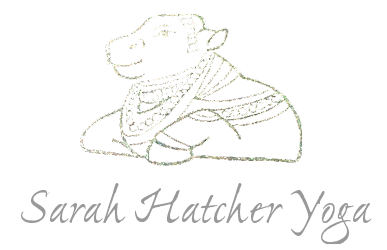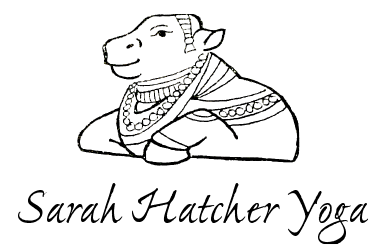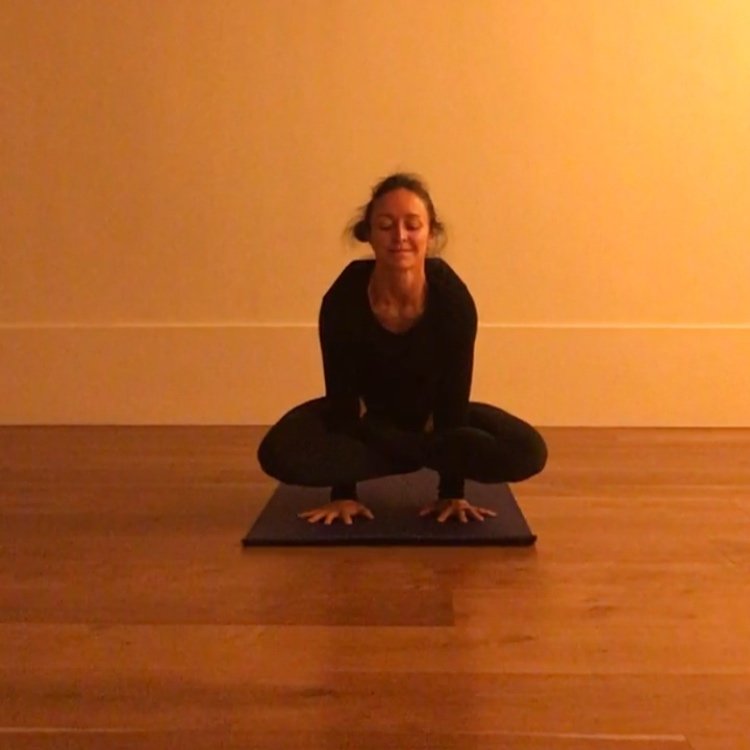Garbha Pindasana - Rock and Roll, baby!
This blog post was published in January of 2012. I have reshaped it in hope that you will feel inspired to practice this potent āsana with a little more curiosity! If you like or dislike this asana - please bring your comments to the blog - the more the merrier!
After I finish my practice,
I often reflect upon the posture that gave me the most grief, the most joy, and the most curiosity. When I am doing the primary series, it is always Garbha Pindasana that takes the cake: it fills the roll of all three. And in the intermediate series - it's a no brainer, of course it is Karandavasana. In the third series, it is Viranchasana B because of the knee intensity and my history of injuries from my days as a youth ski racer.
During my first practice in Mysore, I had a memorable experience with Garbha Pindasana. A woman next to me was attempting the asana at the same time, and we were both rolling at the same time. I stole out of the corner of my eye a smile from Sharath in wonderment of just how these two women were going to make nine rolls without having a bumper-car crash into each other or others around them. We didn't smash, but I'll never forget the focus it took to roll exactly when she did, and how much effort it took to link my breath with hers so that we could be collaborative in our efforts.
Garbha Pindasana is one of the most important postures for me to come back to often. I have a mild scoliosis in my thoracic spine and the unexpected relief I receive while rolling directly on my spine gives me a lightness through my back that I experience in no other way. Also, I find that GP gives me a preparation for all of the deep leg-behind-the-head postures and backbending of the advanced series that are to come.
I recently started taking this posture before I do my practice if I am not doing the primary series. The intermediate and third series do not have a dynamic rolling posture anything close to this one, and I find that practicing GP before practicing intermediate or third series brings clarity and wisdom to my spine.
If you have any doubts about this posture, be sure to learn this posture from a trained teacher. It is advised that you can do padamasana easily before attempting this asana as well as Marichyasana D. And don't just go start rolling around like a nimwit - be sure you are rolling directly on the spine and not on the side, or too fast or too slow. Roll with the breath, deeply - exhaling on the roll down and inhaling on the roll up.
The rolling part is the most important part! The rounded shape you need to create in order to roll successfully gives the entire spine a kyphotic curve. By doing this, the spine gets massaged, relieved, and also, we emulated our earliest backbone's shape, how we were in-utero and this is a huge boon when we can track back to a time when there is little memory.
Understanding more and more about your own body (it's strengths and weaknesses) is mandatory as you go deeper and deeper into your ashtanga practice. This may mean that you research which asanas give you relief and pain. There may be something hidden that you may only learn about through reflection and study.
In Gregory Maehl's book, "Ashtanga Yoga - the Intermediate Series", he offers insight into the spine's earliest shape that I am always tapping into.
"The sacrum has a kyphotic shape. It is part of the primary curvature that the infant acquires in the womb, where the entire spine in curved in this direction. The thoracic spine is the other area of the spine that has retained its primary curvature. Two areas of the spine adapt to a lordotic (bent backward) curvature during the maturation process to produce the double S curve of the spine of the upright walking hominid. The lordotic curve of the cervical spine begins to form during infancy with the constant effort of lifting the head while lying on the belly; it is necessary to support our heads in an upright position. The lordotic curvature of the lumbar spine begins to form when we stand upright and start to bear weight in an upright position" (p. 66)
If you struggle with lotus or have knee pain, have a flat or stiff back lower back, or have a thin mat and are skipping this asana, still do the asana with crossed legs by wrapping your arms around your legs and holding your hands together in front of you. Put a blanket underneath you to soften the surface below you to make the rolling more comfortable. Hold this for five breaths and then roll. Then lift up in lolasana to mimick the Kukkutasana gesture for five breaths.
Seeing people smirk at this posture is a dire loss, as the breathing-inspired rolling sends us into a state of breathing bliss. Also, a relationship with uddiyana bandha ignites as we use the breath and the bandhas as a softening buffer to the lower back as we roll.
As I venture further and further into the practice, this is the posture that continues to inspire me. It is also the most unusual asana of the primary series and you can work this asana into Kukkutasana to gain strength for all the arm balances ahead in the practice.
May you too discover which asanas are best for your body and spirit by paying attention, listening, observing and reflecting. Above all, it is your duty to pay attention, yogi! When you DO have an "Oh yeah!" moment, you will be smart enough not to miss it.

Saraswati, with your knowledge and wisdom, may you teach us the ability to listen and study - may you guide us in our efforts towards higher thinking and intelligence. From Down to Earth Yoga Studio, Bozeman, Montana. Thank you, Randa.


